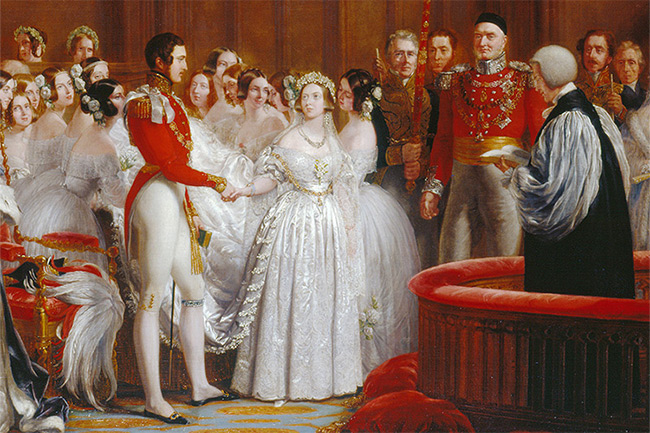
On 10 February 1840 Queen Victoria married Prince Albert, the German Prince of Saxe-Coburg and Gotha, in one of the greatest love matches in British history.
Smitten with him from the day they met, the pair would rule over a golden age of British industrial growth and birth a family tree large enough to place its members in many of the royal courts of Europe. Here are 10 facts about their famed marriage.
1. They were cousins
 Watch Now
Watch NowMany argue that Victoria and Albert had been intended for one another long before they ever met, through the schemes and plans of their family – the same family, seeing as Victoria’s mother and Albert’s father were siblings.
In the 19th century, members of the aristocracy would often marry distant members of their own families to strengthen their faction and influence. The two seemed like a good match, being born just three months apart, and were finally introduced in May 1836 when Victoria was seventeen and Albert just shy of the same age.
Victoria was immediately attracted to the young prince, describing him in her diary as ‘extremely handsome’ with a ‘beautiful nose and a very sweet mouth’.
2. Albert was not William IV’s first choice for his niece
As was common with such royal matches, and particularly with regards to the inheritance of the throne, political gain was an important prerequisite to marriage. Thus, Albert was not the first choice of the King of Great Britain – the aged and grumpy William IV.
William disapproved of the tiny state of Saxe-Coburg as one fit to produce a consort for the future queen, and instead wanted her to marry Alexander, the son of the King of the Netherlands and member of the House of Orange.
Victoria was highly unimpressed upon meeting Alexander and his brother however, writing to her uncle Leopold that
‘the Netherlander boys are very plain…they look heavy, dull, and frightened and are not at all prepossessing’
before quipping,
‘so much for the Oranges, dear Uncle’.
Alongside the extremely favourable description of his appearance previously mentioned in her diary, she wrote to Leopold after the meeting saying that ‘he possesses every quality that could be desired to render me perfectly happy’.
As the couple were still very young, no official arrangements were made, yet both sides were aware that a match was likely one day.

Prince Albert by John Partridge (Image Credit: Royal Collection / Public Domain).
3. She was in no rush to marry
In 1837 however, William IV died childless and Victoria became an unexpected teenage queen. All eyes turned to the prospect of her marriage, as many believed that a young woman was not strong enough to rule alone. Due to her unmarried status, she was even required to remain in the household of her mother, with whom she shared a fractured relationship.
Victoria believed herself still too young to enter into marriage however, and when Lord Melbourne suggested she marry to escape her mother’s suffocating presence, she replied that the idea was a ‘shocking alternative’.
Despite her attraction to Albert when they had last met, the new queen put off a second visit from him until October 1839.
4. Victoria proposed to Albert
This visit was an even greater success than the first however, and any hesitations about marriage fizzled away. Just five days into the trip, the young queen requested a private meeting with Albert, and proposed, as it was the monarch’s prerogative to do so.
With much joy he accepted, in what Victoria termed the ‘happiest brightest moment in my life’. They were married on 10 February the following year in the Chapel Royal at St James’ Palace in London.
5. The wedding set off a number of traditions
The royal wedding of Albert and Victoria was unlike any other, and began a number of traditions still observed today. Straying from the royal protocol of holding private wedding ceremonies at night, Victoria was determined to let her people see the bridal procession in the light of day, and invited more guests to observe it than ever before. This opened the door to more publicised royal weddings.

10th February 1840: Queen Victoria and Prince Albert on their return from the marriage service at St James’s Palace, London. Original Artwork: Engraved by S Reynolds after F Lock. (Photo Credit: Public Domain)
She dressed in a white gown, exuding purity and allowing her to be seen more easily by the crowds, and dressed her twelve bridesmaids in the same. As the dress was fairly simple and easy to recreate, a boom of white wedding dresses began, leading of course to the well-established tradition of the modern day.
Their wedding cake was also vast, weighing around 300 lbs, and required four men to carry it. Following the event, another tradition was born when Victoria planted the myrtle from her bouquet in her garden, in which a sprig would be later used for Elizabeth II’s bridal bouquet.
6. Victoria was ecstatic
In Victoria’s lifelong and extensive diaries, she described her wedding night with all the excitement of a new bride, beginning the entry with,
‘I NEVER, NEVER spent such an evening!!! MY DEAREST DEAREST DEAR Albert…his excessive love & affection gave me feelings of heavenly love & happiness I never could have hoped to have felt before!’
She went on to describe the day as the happiest of her life, and praised her husband’s ‘sweetness & gentleness’.
7. Albert became a valuable advisor to Victoria
From the outset of their marriage, the royal couple worked alongside one another with competence – literally moving their desks together so that they could sit and work side-by-side. The prince had been educated at the University of Bonn, studying law, political economy, history of art and philosophy, and was thus well-equipped to assist in state business.
Albert in particular helped to guide her through difficult stretches of her reign such as the Irish potato famine in 1845, and through her grief following her mother’s death in 1861 despite his own ill-health.
8. They had a large family
Despite a well-publicised hatred of babies, Victoria gave birth to nine of them between 1840 and 1857 – four boys and five girls. Most of these children married into other European royal families, affording her the title ‘the Grandmother of Europe’ in later life.
This meant, intriguingly, that the King of the United Kingdom, the Kaiser of Germany and the Tsar of Russia during the First World War were all first cousins and grandchildren of Victoria.

Tsar Nicholas II of Russia with King George V of England, who bear a striking resemblance. (Image Credit: Hulton Archives / Getty Images / WikiMedia: Mrlopez2681)
9. Their marriage was not all bliss
Despite their reputation as the perfect marital couple, Victoria and Albert’s relationship was often fraught with arguments and tension. Victoria’s pregnancies took a large toll on her, and often created a power struggle between the pair as Albert took over many of her royal duties.
She reportedly suffered from post-natal depression, and during her last two pregnancies was even prone to hysterical episodes, in which her physicians began to suspect her of inheriting her grandfather George III’s madness.
Following one such episode, Albert wrote Victoria a rather telling yet patient note stating,
‘If you are violent I have no other choice but to leave you…and retire to my room in order to give you time to recover yourself’.
 Watch Now
Watch Now10. Albert died whilst trying to patch up a royal scandal
While in their 21st year of marriage, the couple caught wind of a scandal involving their eldest son and heir Bertie, and a well-known Irish actress with whom he was having an affair. Albert travelled to Cambridge to personally scold his son, during which he fell terribly ill and died of typhoid fever in 1861.
Victoria fell into a period of intense mourning and seclusion that lasted five years and caused vast rifts in her popularity. She blamed her son for her husbands death, and their relationship worsened. As a testament to her everlasting love, Victoria was interred with one of Albert’s old dressing gowns upon her death at the age of 81.

Prince Albert and Queen Victoria with their children by John Jabez Edwin Mayall. (Image Credit: Public Domain)















